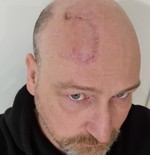Cancer Council SA data shows that men are less likely to protect their skin than women. Darren Adams knows all too well the impact of a skin cancer diagnosis. He was diagnosed with skin cancer in 2018 after noticing a sore on his face that didn’t heal.
Darren noticed a sore on his forehead which he thought was from an old cricket helmet he’d been wearing. He was fairly certain the sore was from the Velcro irritating his skin—and wasn’t too concerned. But when the sore still hadn’t healed by the following cricket season, Darren decided it was time to get it checked out.
“I went to visit my GP, thinking it was a sore from my cricket helmet and he confirmed that it was actually a basal cell carcinoma, which was a bit shocking. Especially when he said I’d had to have it cut out and stitched up,” Darren said.
After testing, Darren was told the cancer was outside preferred margins and to keep an eye on it—looking out for any changes in colour, size, shape, or texture.
“Around March 2021, I thought the scar was looking like it had changed, so I returned to my doctor for a check-up. Sure enough, the cancer was back. Two weeks later I had surgery, where they test the cancer as they cut—and remove more, if needed. The good thing is they try to get all the cancer in one go,” Darren said.
Unfortunately, the surgeon had to make a wider incision in Darren’s forehead than expected—it couldn’t simply be stitched back together, or he’d have a permanently raised right eyebrow.
“Instead, they had to carve a big reverse C in my head to have enough skin to stretch down to accommodate what they’d taken out. As a result, my forehead is quite stretched, the recovery was slow. A quarter of my head remains numb, and my right eye feels like it’s open whenever it’s actually closed,” Darren said.
“In the past I was a bit blasé about sun protection, which didn’t help. All you guys out there, playing sport or spending time outside, learn from my experience. It’s not hot days that cause skin cancer, its UV radiation, so make sure you check the UV and cover up—sunscreen alone isn’t going to cut it.”
New data from the South Australian Cancer Registry shows that every year, more than double the number of South Aussie men are dying from melanoma than women.
Cancer Council SA have launched their new sun protection campaign in partnership with Wellbeing SA. The campaign, which targets South Aussie men, highlights that when you cover things up, they last longer. Cancer Council SA Prevention and Advocacy Manager Christine Morris says the same rule applies to ‘things’ like your car, your deck and your barbecue—and your skin.
“Protecting your skin through the five SunSmart measures—slipping on sun protective clothing, slopping on sunscreen, slapping on a hat, seeking shade and sliding on sunglasses is the best way to protect against harmful UV radiation,” Christine said.
“It’s really important that South Aussie men get on board with sun protection and set a good example for children. We know sun protection is the best way to reduce you and your family’s skin cancer risk, and more importantly, make sure that you’re around to continue to enjoy the things you love with those that mean the most to you.”
For more information about protecting your skin in five ways—slip, slop, slap, seek and slide—visit sunmart.org.au
Learn more about the ‘Same Goes For You’ SunSmart Campaign here.
